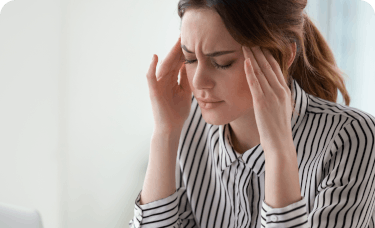Headaches are an unwelcome source of pain at any time of day, but when theyinterfere with sleep, they can also lead to grogginess and irritability. Whether your nighttime headaches start as you’re getting ready for bed or wake you up in the middle of sleep, they can usually be treated or prevented.1 Learn the causes of different types of nighttime headaches to find out how to avoid experiencing headache pain at night.
Nighttime Headache Causes and Symptoms
A headache can refer to pain in any region of the head and may occur on both sides of the head, be isolated in a certain location or radiate across the head.1,2 Headaches may involve sharp pain, dull aching pain or a throbbing sensation.2 Depending on the type of headache you experience at night, the cause of your headache and your treatment options differ.1
Tension Headaches
Tension headaches are the most common type of headache and can occur during the day or the night.1 The pain associated with tension headaches ranges from mild to severe.1
Although the exact cause of tension headaches is unknown, they’re typically triggered by stress, exhaustion and muscle tension. After a long or stressful day, you may experience a nighttime tension headache. For some people, teeth grinding during sleep can trigger a tension headache and may even wake them.
Common tension headache symptoms include:1
- Pain on both sides of the head or forehead
- Dull, aching or squeezing head pain
- Slow onset of pain
- Mild to moderate pain
- Tenderness in your neck, shoulders or scalp
Tension-type headaches usually do not cause nausea, vomiting or light sensitivity.1
Cluster headaches
Cluster headaches cause severe pain.1 They tend to occur several times within a span of weeks or months before disappearing.1 People sometimes describe cluster headaches as feeling like an ice pick is in their eye. Cluster headaches often start at night, a few hours before going to bed. The cause of cluster headaches is unknown, and they don’t appear to have any triggers. Symptoms of cluster headaches include:1
- Severe head pain, typically located around one eye
- Headaches that repeat at the same time each day
- Pain that begins on one side of the head
- Redness, swelling, drooping or tearing in the affected eye
- Stuffy or runny nose









